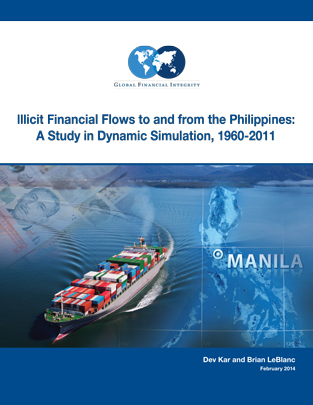The Philippine economy lost at least US$132.9 billion in illicit financial outflows from 1960 to 2011. These outflows represent the proceeds of crime, corruption, and tax evasion, and have serious negative consequences for the Philippines. Outflows were found to significantly decrease domestic savings. A 10% decrease in illicit outflows was found to increase the amount of domestic savings of between 1.3% and 1.9%.
The report is the fourth country case study by Global Financial Integrity, and the first to incorporate re-exporting data from Hong Kong, and to estimate tax revenue loss from illicit inflows and outflows.
Primary Findings
The Philippine economy lost at least US$132.9 billion in illicit financial outflows from 1960 to 2011.
These outflows represent the proceeds of crime, corruption, and tax evasion, and have serious negative consequences for the Philippines. Outflows were found to significantly decrease domestic savings. A 10% decrease in illicit outflows was found to increase the amount of domestic savings of between 1.3% and 1.9%.
Furthermore, the report found US$277.6 billion in illicit inflows to the Philippine economy, primarily due to trade under-invoicing, also known as technical smuggling.
Combined, the inflow and outflow of illicit capital have tremendous consequences for Philippine economic growth, crime, and governance.
Tax Revenue Loss
For the first time, GFI introduced a methodology to measure tax revenue loss due to trade misinvoicing in the Philippines. The study found that since 1990, the Philippine Treasury lost US$23 billion from customs evasion.
In 2011, the Philippines lost US$3.85 billion in lost tax revenue, which is twice the size of its fiscal deficit, and equal to 95% of the total government expenditures on social benefits that year.
Underground Economy
The report estimated that the size of the Philippine underground economy averaged 34.8% of GDP over the study period, and 29.7% of GDP in 2011. Larger underground economies facilitate crime and corruption and decrease tax revenue collection.
Illicit flows were found to both drive the underground economy and be driven by it, a result also found in country profiles of India, Mexico and Russia.
Methodology
This authors believe this study to be the most methodologically rigorous profile of a single country’s illicit financial flows to date. The study was first country profile to incorporate re-exporting data from the Hong Kong Customs and Excise Department, which first appeared in December’s 2013 annual report by the same authors.
Control of Corruption
The study finds very strong correlations between the World Bank’s Control of Corruption indicator and total illicit financial flows to and from the Philippines over the time period.
The authors note that while Philippine trade misinvoicing relative to total trade increased by 3% per annum between 1960 and 2011, the same indicator declined relative to total trade in South Korea declined by 4% per annum over the time period. The difference experiences of South Korea and the Philippines contrast the quality of governance in each country, which deterioriated in the Philippines while strengthening in South Korea over the study period.


